Best Pulse Oximeters of 2021
Pulse oximeters make it easy for people suffering from respiratory illness, heart disease and other conditions to obtain a fast, accurate readout of their blood oxygen level. As a result, they are able to make informed decisions about their health.
Today’s pulse oximeters are affordable, compact, lightweight devices that are simple to use, completely portable and produce no side effects. We’ve put dozens of today’s most popular models under the critical microscope and concluded that the following are the best pulse oximeters of 2021.
1. Zacurate 500BL Fingertip Pulse Oximeter
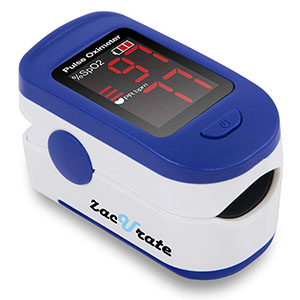
The Zacurate 500BL embodies everything that’s right with today’s pulse oximeters. It’s light, durable, easy to use, provides an accurate reading in about 10 seconds and costs less than a pair of movie tickets. The screen is large and clear and provides real-time information on blood oxygen levels and pulse rate.
There’s a lanyard clip to attach it to your belt or to anchor it inside your backpack. And it’s designed to fit comfortably over the fingers of anyone 12 years old and up. Unlike some other oximeters, the 500BL comes with 2 AAA batteries so you can put it to work right out of the box. The 1-year warranty and top-notch customer service are just icing on the cake. With no real downsides the 500BL is our top choice.
2. ChoiceMed Pulse Oximeter
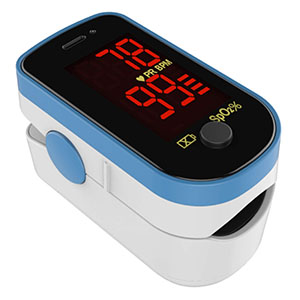
If there were no Zacurate 500BL the ChoiceMed Pulse Oximeter would be an easy #1. It too is light, comfortable, reliable, durable and accurate. In fact, it’s one of the lightest pulse oximeters currently on the market. It also has a reversible readout screen so you do not have to twist your hand around or crane your neck to see your reading.
The ChoiceMed Pulse Oximeter slips over virtually any size finger with ease and returns an accurate reading in about 10 seconds. It comes with its own lanyard so EMTs, hikers, runners and more can bring it along with them wherever they go. The ChoiceMed oximeter comes with 2 AAA batteries and a handsome carrying case with Velcro closure so you can slip it into your carryon bag and take it with you when you start traveling again.
3. SantaMedical Fingertip Pulse Oximeter
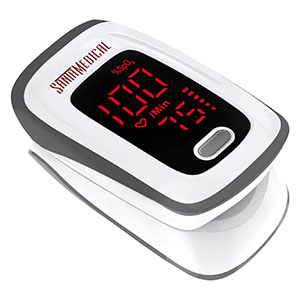
If we were handing out prizes based on looks alone the SantaMedical Fingertip Pulse Oximeter would be the hands-down winner (so to speak). Fortunately, this pulse oximeter is more than just a pretty face. It’s light, fast and accurate and will provide you with your blood oxygen levels (SpO2) and pulse rate in 8-10 seconds.
The LED readout is large and clear and includes a bar graph-style pulse indicator. The included lanyard can be used to sling the device itself, or the handy carrying case, so you can take it wherever you go. At 2.4 ounces it’s one of the lightest oximeters on the market, and it comes with 2 AAA batteries so you can put it right to work. This pulse oximeter from SantaMedical is recommended for those 10 and up and has a 1-year manufacturer’s warranty.
4. Faceil Pulse Oximeter
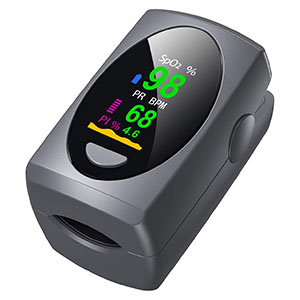
The Faceil Pulse Oximeter has a sleek, agreeable look to it that is an accurate reflection of its simple, reliable operation. At 2.4 ounces the Faceil is light enough for seniors and kids. The OLED display is a step up from the standard LED display in some ways, and produces big bold numbers that are easily read.
The device provides blood oxygen levels (SpO2) along with both heart rate and the strength of your pulse in about 8 seconds. It’s comfortable, extremely easy to use with one button operation, and comes with its own lanyard for easy transport. The device clips on easily and stays in place with little encouragement. Comes with 2 AAA batteries, though it’s missing a carrying case for some reason.
5. AccuMed CMS-50DL Pulse Oximeter
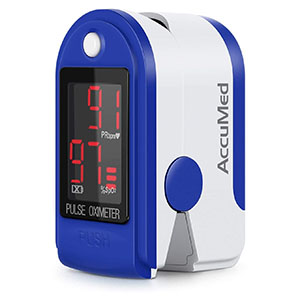
AccuMed tosses their hat into the pulse oximeter ring with their outstanding CMS-50DL. The CMS-50DL is not going to win any design awards, but it does what it’s supposed to do reliably and accurately time after time. You get both SpO2 and pulse measurements in 8-10 seconds.
The information is displayed on a large, easy to read screen. The device slips easily over most fingers, is comfortable, and won’t slip off as long as you stay still. The CMS-50DL shuts off automatically after a minute in order to conserve battery power. It has a lanyard and carrying case so you can take it anywhere and 2 AAA batteries are included.
6. Mibest OLED Finger Pulse Oximeter
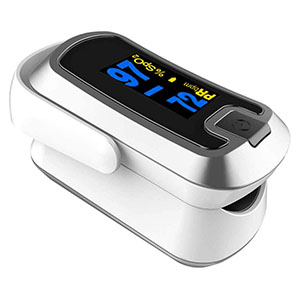
The Mibest OLED Pulse Oximeter has a sleek, contemporary feel and features one of the most user-friendly displays on the market. That OLED display offers 10 brightness settings and changes orientation as you move the device around. As such, it’s always displaying its info in a way you can read it, like a smartphone.
That information includes blood oxygen levels and pulse rate, along with battery level and relative pulse strength. The Mibest OLED Pulse Oximeter is also one of the few oximeters that offers you a range of color options. There’s also a pressure bar that makes for effortless opening, and a lanyard is included for easy transport.
7. SantaMedical Deluxe SM-110 Pulse Oximeter
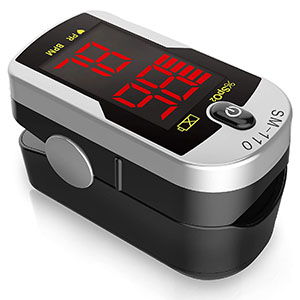
SantaMedical earns a second spot on our list with their Deluxe SM-110 Pulse Oximeter. While it doesn’t have the forward-leaning design of their other Fingertip Pulse Oximeter (see above), it nonetheless secures its place with its big, easy to read display that flips so you can always get an easy reading.
It slips comfortably over the finger and produces the information you need in around 10 seconds. It’s a bit heavier than its sibling, but at just over 3 ounces it’s nothing worth complaining about. The SM-110 comes with 2 AAA batteries, a handsome carrying case and, best of all, a 2-year manufacturer’s warranty.
8. Metene Pulse Oximeter
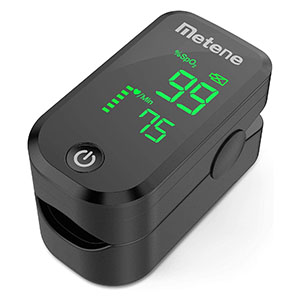
If you’re into minimalist design the Metene Pulse Oximeter should appeal to you. It touches all the bases a great pulse oximeter should touch with fast, accurate output and a large, easy to read screen. That screen displays SpO2 levels and heart rate in 8-10 seconds in most cases. The device weighs a feather-like 2.4 ounces and comes with a lanyard for easy carrying.
The Metene Pulse Oximeter fits comfortably over most fingers, stays in place while it’s gathering information and shuts off automatically if you forget to turn it off yourself. It comes with 2 AAA batteries, but for some reason there is no carrying case.
9. FaceLake FL400 Pulse Oximeter
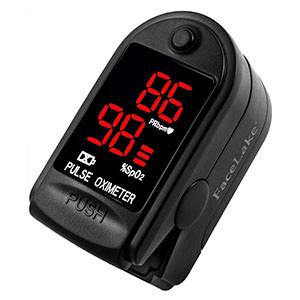
The FaceLake FL400 is a simple, no frills pulse oximeter that’s a good choice for the budget conscious. It’s not the slickest looking pulse oximeter on the market but it returns important information quickly and accurately. And that’s what it’s all about.
The FL400 is well-made, very durable, reasonably lightweight and small enough to take anywhere. The display is basic but large and easy for most to read even in low-light conditions. Unlike some of its more expensive competitors, the FL400 comes with a nifty carrying case and features a full 1-year manufacturer’s warranty on workmanship.
10. Innovo Deluxe iP900AP Pulse Oximeter
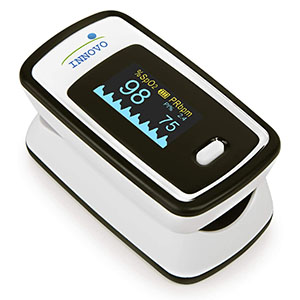
The final pulse oximeter on our list is the iP900AP from Innovo. If there can be such a thing as a ‘deluxe’ pulse oximeter, this would have to be it. Where most oximeters provide simple SpO2 level and heart rate info the iP900AP goes the extra mile with both plethysmograph and perfusion index readouts to complement the standard SpO2 and HR data.
The plethysmograph indicates changes in blood volume, while the perfusion index indicates the strength of a person’s pulse at the place where the reading is taken. This additional information can be especially useful to those with heart disease. Although climbers and aviators will also likely benefit. The iP900AP comes with a lanyard and 2 AAA batteries, though there is no carrying case. It’s also a bit more expensive than some competitors.
FAQs
What Is a Pulse Oximeter?
A pulse oximeter is a small device that slips over the tip of the finger and measures how much oxygen is in a person’s blood. There are oximeters that fit over other body parts such as earlobes, but the fingertip oximeter is by far the most popular type. The pulse oximeter is used by heart patients, athletes, people taking certain types of medication, people with sleep apnea (1), and many others.
How Does a Pulse Oximeter Work?
The pulse oximeter sends a beam of light into the fingertip. This beam of light assesses the color of the blood. Blood with a rich red hue is well-oxygenated. If the color of the blood is purplish that indicates less oxygen. And if the blood is bluish that indicates a low level of oxygen in the blood. The algorithm within the pulse oximeter has already assigned specific values to specific colors on the color spectrum. So when the light detects a specific shade of, say, purple, the oximeter displays the predetermined value for that color.
Is a Pulse Oximeter Accurate?
Measuring oxygen levels by the color of the blood is not quite as accurate as drawing blood and submitting it directly to a machine to check its oxygen levels. But color is a more accurate measuring stick than most people realize. The best commercially available pulse oximeters are considered to be accurate with about 2% of what the actual oxygen content of the blood is. That said, if you need the most accurate reading possible you should always go to your doctor and have them conduct a blood gas test (2).
What are the Benefits of a Pulse Oximeter?
A pulse oximeter helps people reduce time tethered to the tank. There are numerous conditions that call for the use of supplemental oxygen at home (3). But, until recently, people were often tethered to the oxygen tank all day every day. That’s because there was no way for them to monitor their blood oxygen levels so that they’d only use the oxygen when it was really needed. Now there is. The pulse oximeter provides an easy way for a person to determine if it’s time to use the oxygen tank.
A pulse oximeter can help you measure physical performance. Exercise is important regardless of your age. But it’s not always easy to figure out if you’re getting any benefit from the exercise you’re doing. A pulse oximeter can help. Raising blood oxygen levels is a key component of effective exercise (4). The pulse oximeter can let you know how you’re doing and whether you need to adjust your exercise routine in order to optimize results.
A pulse oximeter is useful for those with asthma. According to the Centers for Disease Control (CDC), some 25 million Americans have asthma (5). It can be extremely useful for these folks to track their blood oxygen levels. A pulse oximeter can allow them to do that with a high degree of accuracy. By tracking blood oxygen levels and sharing the information with their doctor they can help the doctor fine-tune their treatment.
A pulse oximeter helps monitor sleep apnea. Sleep apnea is no joke. It played a role in the death of Star Wars actress Carrie Fisher (6) as well as thousands of other Americans every year. Some of those with sleep apnea use what are known as CPAP machines (7) which help keep their airways open at night. With a pulse oximeter, these folks can keep track of their blood oxygen levels in order to ensure their CPAP therapy is working as intended.
A pulse oximeter can be useful for pilots. Pilots, especially those that fly small, unpressurized planes, often flirt with dangerously thin air. It’s crucial that they are able to stay awake and alert at all times and a pulse oximeter can help them do that. Pilots need to make sure their blood oxygen does not fall below 90% of normal. If it does they could become confused and disoriented, or even pass out. Having a pulse oximeter in the cockpit at all times is a smart thing to do.
A pulse oximeter is a good tool to take hiking. Pilots are not the only ones who spend time in thin air. Mountain climbers often wind up in air so thin that there is precious little oxygen to breath. This often results in a phenomenon called ‘altitude sickness’ (8) and it typically begins to affect people around 10,000 feet above sea level. (Some, however, may feel the effects at lower altitude, and others not at all.) Having a pulse oximeter in your backpack can help you determine when your blood oxygen is getting dangerously low so you can turn around or hook up the supplemental oxygen.
A pulse oximeter can help you fend off drug side effects. Numerous medications have the unfortunate habit of interfering with respiratory function. Perhaps most notably those used to treat rheumatoid arthritis (9). It’s important that people in danger of suffering drug-induced lung problems be able to monitor their condition in real time. A pulse oximeter is a great way for them to keep an eye on pulmonary function so that they can maximize the benefits of their treatment and minimize problems.
Pulse oximeters are non-invasive. Having your doctor conduct a blood gas test to determine your blood oxygen levels will no doubt provide you with the most accurate possible reading. But it will also require your doctor to stick you with a needle to draw blood. A pulse oximeter will provide you with a reading that is only 2 or 3 percent less accurate and it will not require that you subject yourself to a needle.
Pulse oximeters are portable. The best pulse oximeters weigh only a few ounces and are small enough to easily slip into your work or school backpack, purse, fanny pack or those leg pockets on your cargo pants. As such, you can take them anywhere you want, including on an airplane. So next time you’re heading out for a weekend of backpacking or you’re flying out on a business trip or vacation, remember to take your pulse oximeter.
A pulse oximeter is useful for those with COPD. Chronic Obstructive Pulmonary Disease, or COPD (10), is the result of chronic inflammation which obstructs the normal flow of air into and out of the lungs. People with COPD have difficulty breathing and tend to cough and wheeze quite a bit. COPD has many causes, including cigarettes and air pollution. For those with COPD who use an inhaler to help keep their airways open, a pulse oximeter can tell them whether the inhaler is effective or not.
Pulse oximeters help EMTs make accurate assessments. When an EMT arrives at the scene of an accident or at the home of someone in distress they need to make a fast, accurate assessment of the situation. Wasted minutes could mean lives. The pulse oximeter is a fast, easy way to get a handle on the situation, stabilize the person in need, and get them on their way to the hospital quickly and safely.
Anyone can use a pulse oximeter. The pulse oximeter is incredibly easy to use. For that reason, it’s a good idea for the elderly, kids with asthma, athletes and more to have one on hand at all times. Some, not all, pulse oximeters can read blood pressure too. So they’re perfect for those suffering from hypertension as well. Just switch the device on, place it over the end of your finger and within about 10 seconds you have your reading.
Pulse oximeters still work when the power goes out. People don’t stop having asthma, or COPD, or heart disease when the power goes out. They still need to monitor their health no matter what is going on with the grid. Fortunately, pulse oximeters are battery-driven. So even in the case of a prolonged blackout caused by a natural disaster a person in need can still monitor and maintain their health.
Pulse oximeters are cost-effective. The first devices that would lead to the modern pulse oximeters appeared in the 1970s and were the brainchild of Japanese researcher Takuo Aoyagi (11). Those early devices were enormous and cost tens of thousands of dollars. Fast forward 50 years to the digital age and we have the modern pulse oximeter that fits on the tip of your finger and costs less than a pair of blue jeans.
Are There Things That Can Affect the Accuracy of a Pulse Oximeter?
There are a few things you should be aware of that could affect the readout of a pulse oximeter. The first is cold hands. In the cold weather months you should take your readings in a warm environment if possible, and give your hands a few minutes to warm up before doing so. Nail polish can also interfere with pulse oximeter readings, as can false nails. Also, always make sure the finger you are placing in the oximeter is lower to the ground than your heart.
Will a Pulse Oximeter Alert Me to a Heart Attack?
A pulse oximeter can alert a person that a heart attack is underway. And it can indicate that you are entering dangerous territory with regards to your blood oxygen levels. But it is not a predictive tool. You can’t put it over your finger and determine that in 10 minutes you’re going to suffer a heart attack. Heart attacks are like earthquakes. The risk factors are well understood, so it’s possible to say that one will likely occur in the future. But nailing down exactly when it might happen is nearly impossible.
The Bottom Line
The pulse oximeter is a simple, effective way to determine the level of oxygen in a person’s blood at any given time. This is important for people with asthma, chronic bronchitis, heart disease and numerous other conditions.
Pulse oximeters are affordable, compact, can be taken anywhere and don’t need to be plugged in. They can also be effectively used by people from 8 to 98. If you or a loved one suffer from respiratory distress, or a condition that affects the cardiopulmonary system, consider getting a pulse oximeter.


4 Comments
Reviewing the Best Pulse Oximeters of 2020 – Nutrition Diet News · November 3, 2020 at 4:27 pm
[…] source https://nutritiondietnews.com/best-pulse-oximeter/ […]
Reviewing the Best Pulse Oximeters of 2020 – Diet Tips By Paul · November 3, 2020 at 4:39 pm
[…] source https://nutritiondietnews.com/best-pulse-oximeter/ […]
Reviewing the Best Pulse Oximeters of 2020 – Health Updates By Evelyn · November 3, 2020 at 5:34 pm
[…] Via https://nutritiondietnews.com/best-pulse-oximeter/ […]
Reviewing the Best Pulse Oximeters of 2020 – Nutrition News By Agnes · November 3, 2020 at 6:04 pm
[…] source https://nutritiondietnews.com/best-pulse-oximeter/ […]
Comments are closed.